Splintering the Veneer of the City
Two exhibitions that excavate the feel of a place beneath its smooth surface, and shift what spaces are worthy of attention and care
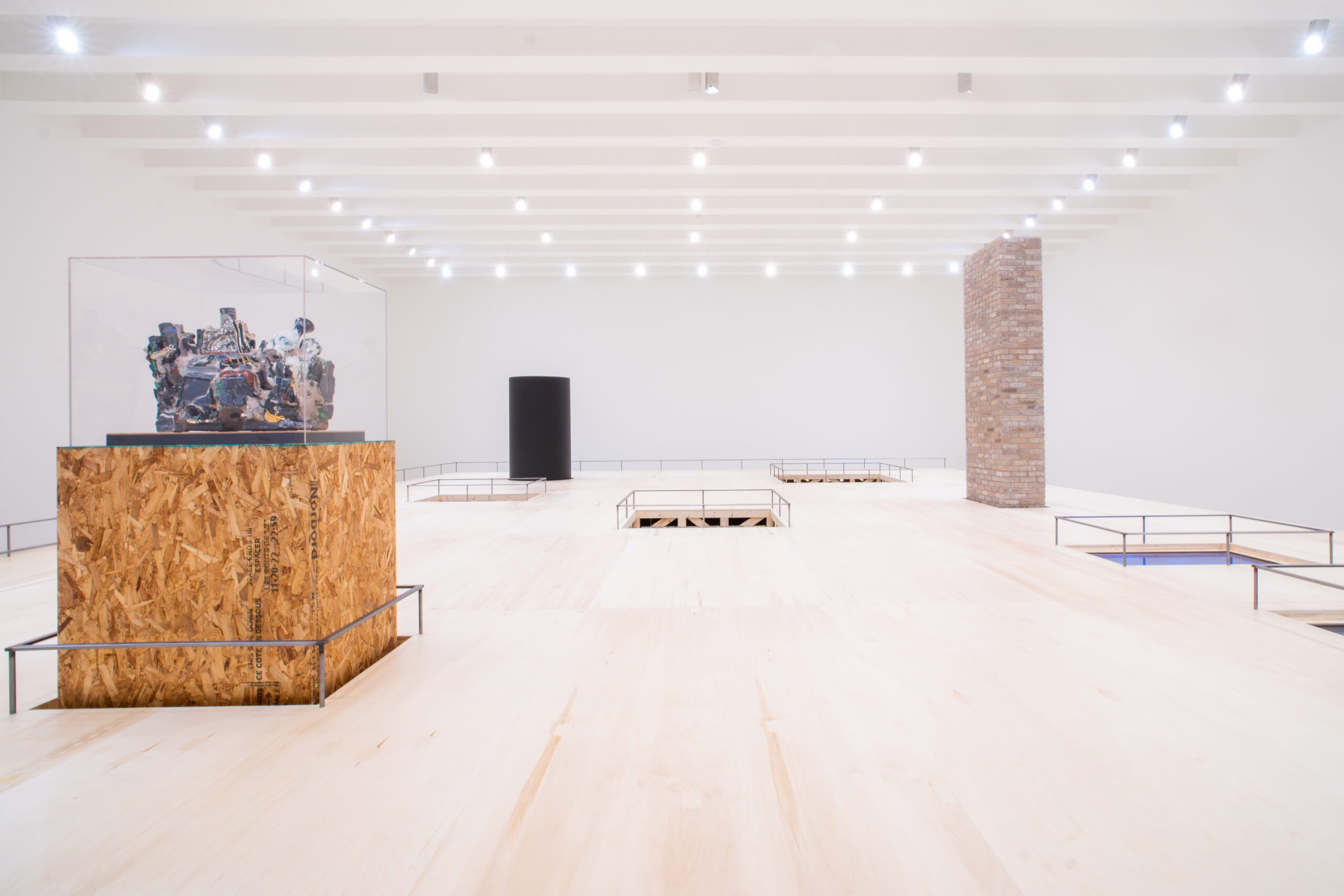
In the opening pages of Katie Kitamura’s 2021 novel Intimacies,1 the narrator remarks: “Increasingly I’d begun to think the docile surface of the city concealed a more complex and contradictory nature.” Intimacies is set in The Hague, the Dutch city that hosts the International Criminal Court, where the unnamed narrator has just become a translator. The novel’s emotional stakes are high, the narrator dealing with the loss of her father, a dissolving marriage, and the strain of her assignment: interpreting for the former president of a West African country standing accused of war crimes. Even so, Kitamura’s prose is cool and precise, written with the exactitude of a translator abidingly conveying the subtleties of someone else’s words.
Kitamura’s just-barely-concealed writing style is at home in The Hague, where “the city’s veneer of civility was constantly giving way.” The narrator offers an anecdote: three uniformed men slowly march down a pedestrian street alongside a machine. She pauses to consider “what manner of slow-moving work they were doing.” Eventually, she sees they are picking up cigarettes wedged between the walk’s cobblestones, feeding them into a vacuum. “The three men were almost certainly immigrants, possibly Turkish and Surinamese. Meanwhile, their labor was necessitated by the heritage aesthetic of the city, not to mention the carelessness of a wealthy population that dropped its cigarette butts onto the pavement without a thought.” The anecdote is small, but a stand-in for something larger: of The Hague as a symbol of Western-oriented world ordering, where a dissolving ideal of international justice is preserved through a court with eroding legitimacy. Consumed by such ordinary observations and court procedures, a vague, bureaucratic kind of violence envelops The Hague of Kitamura’s imagining.
I often think of Intimacies when visiting somewhere for the first time—not seeking out something foreboding, but getting a feel for a place beneath its “docile surface.” Kitamura’s writing came to mind again on a recent trip to Rochester, Minnesota, the city self-branded as America’s City of Care and Innovation. Like The Hague, Rochester has also become synonymous with its predominant institution: the Mayo Clinic, widely recognized as the country’s top hospital. Though it mainly encompasses two urban campuses, the entire downtown resembles an extension of the medical center. Many of its buildings recall the muted tan and cold blue of a hospital corridor; numerous hotels cater to the 1.4 million patients treated at the Mayo Clinic annually, who largely arrive from out of town. But just as there are cracks to the veneer of Kitamura’s city, there are glitches here, too—including a number currently exhibited on the uppermost level of the Rochester Art Center.


Curated by Zoe Cinel, A Lapse into the Ephemeral features works by six artists and collectives experimenting with 3D scanning, a process that creates digital models of real-world objects and spaces. The technology has wide applications, from the fields of dentistry to archaeology. Each artist in A Lapse into the Ephemeral reappropriates these tools to examine the people and spaces at the peripheries of contemporary landscapes, employing 3D scanning to lend a sense of permanence to marginalized narratives and places.
Benjamin Busch and Sadia Sharmin’s two-channel video installation Amader Pathagar (A Library of Our Own), for instance, zooms in on Karail Basti, a self-organized settlement built atop a landfilled lake in Dhaka, Bangladesh. The neighborhood’s residents are under constant threat of eviction by a government bent on beautifying the lake and using the land for an IT park.2 A screen presents interviews where members of the district’s community-run Shaheed Rumi Memorial Library discuss their political activities and private ambitions; meanwhile, Busch’s 3D renderings of the library are projected behind the screen. The scanning suspends the library in time, offering a dynamic visualization of an institution that, at least in this imagining, will not be moved.
shirin anlen’s Tzina: symphony of longing also centers a space that does not neatly fit into its city’s dominant aesthetics. Described as a “virtual reality documentary,” Tzina’s subject is Dizengoff Square, a public park situated in the heart of Tel Aviv, Israel, from its construction in 1934 to its demolition in 2017. The square was split-level, with a pedestrian plaza elevated and secluded from a busy thoroughfare. A fountain was stationed at its center, around which congregated, in anlen’s words, “the lonely and marginalized characters of the area.” This is the version of Dizengoff Square that anlen and her collaborators faithfully rendered, allowing viewers to navigate and interact with recordings of those who daily frequented the plaza. Each pixelated figure shares their story, most relating to a trauma endured or a love lost. While they speak, squat high-rises loom in the near distance, reminding of the rationale for the square’s demolition: that the city had condemned its inhabitants as blemishes to the neighboring business district. Installed in a gallery that looks out on Rochester’s own row of nondescript hotels and medical offices, I cannot help but think of the Mayo Clinic’s recent trend of acquiring and shuttering rural hospitals—between 2009 and 2019 alone, the health system has closed at least 19 medical facilities in southern Minnesota, Wisconsin, and Iowa, declaring their services unprofitable.3 On these grounds, anlen’s project becomes a proxy for the global pressures exerted on the people and places not considered immediately productive to a city’s veneer of innovation and order.
As Cinel writes in her accompanying essay, the question “What is worth preserving?” circulates throughout the exhibition. That question is answered literally with the inclusion of prints and video from Oddviz, an Istanbul-based collective that uses 3D modeling techniques to capture the street ephemera and overlooked infrastructure of various cities. Instead of picturing iconic skyscrapers or monuments, the team creates renderings that arrange the likes of vandalized bollards, sticker-covered newspaper stands, and utility poles into new compositions that mirror a city’s hectic energy. The images celebrate mundane urban life, positing that a sense of place doesn’t arise from a city’s mottos or commercial centers, but its corners and the points where disparate surfaces collide and overlap.
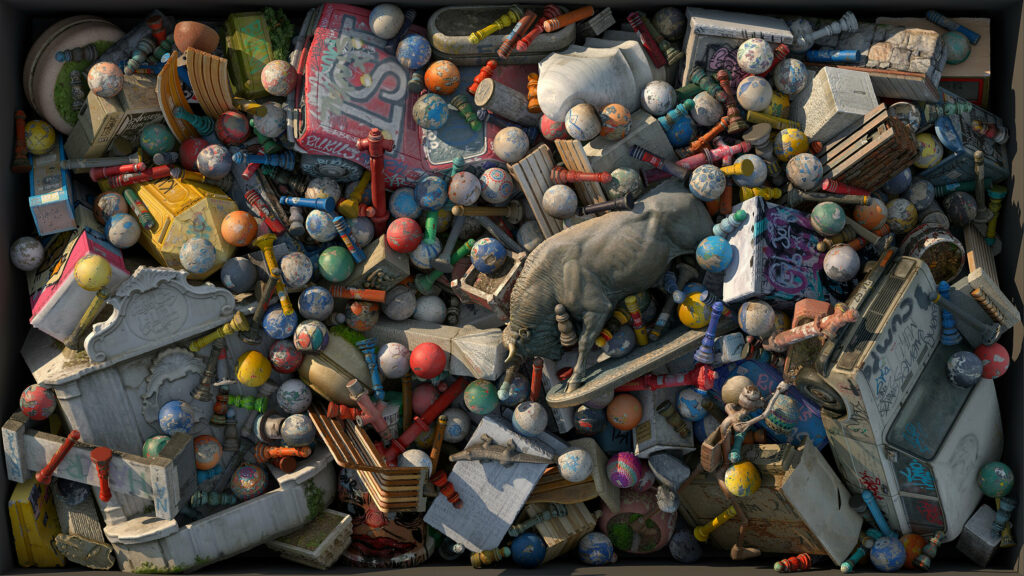
Taken together, the artists of A Lapse into the Ephemeral remind their viewers that ordered streets like those outside the art center are not a given, but the result of a particular kind of world-making. From their distinct vantage points, each offers a different way of understanding place, asserting an alternative value system for assessing the spaces and narratives worthy of preservation and care.
Back in Minneapolis, with his new solo exhibition at the Walker Art Center, Kahlil Robert Irving also asks viewers to reconsider what parts of an urban landscape are deserving of attention. Whereas the artists of A Lapse into the Ephemeral utilize 3D scanning technologies, Irving turns to one of the earliest materials humans worked with: clay. He is perhaps best known for his ceramic sculptures, bulky assemblages that consist of—to name a few regular inputs—glazed and unglazed clay, glass, porcelain vases, and collected and personally-made decorative elements, all of which are joined and fired together before photographs, newspaper clippings, and printouts from web pages are intuitively collaged to the surface. Archaeology of the Present contains one such sculpture placed atop a case of sheathing lumber. Protected in a glass cube, it appears like something freshly unearthed, sitting on display while waiting for its other parts to be found so that sense can be made of the larger whole.
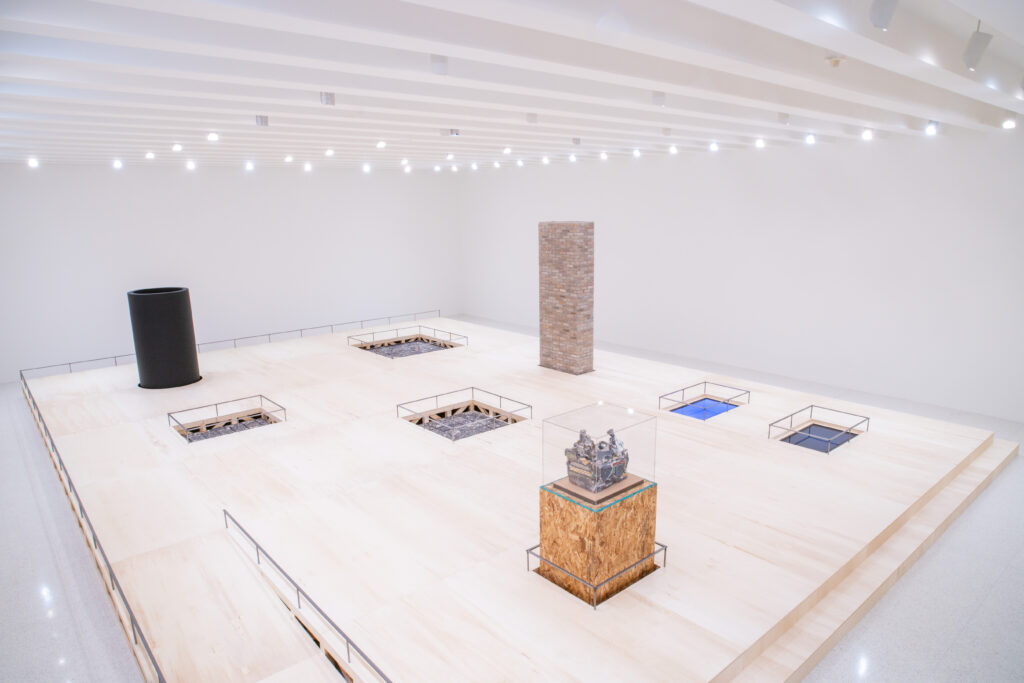
Though the gallery text states that the plywood platform encompassing Irving’s installation “resembles a stage,” its closer comparison might be to the scaffolding raised above an archaeological dig site. In a conversation on The Modern Art Notes Podcast,4 Irving noted that his engagement with archaeology began while studying abroad in Jerusalem where he visited the Church of the Nativity, the basilica built on the site where many Christians believe Jesus was born. “When I entered the church, the whole interior of the building was covered in scaffolding and they were revealing mosaics on the floor.” This experience—of witnessing “how parts of the past are being revealed [in the present]”—helps frame his process, which collapses history and the present day to, as the gallery text puts it, uncover “contemporary artifacts.”
Irving recreates the sensation of a slow reveal in Archaeology of the Present, with low metal railings indicating where he has installed grids of ceramic tiles. These are not the ancient mosaics of a basilica, but representations of a city street, speckled with bits of white clay to look like asphalt. The hand-pressed tiles are cracking and bumpy at the edges, littered with torn newspaper and everyday objects—a crushed aluminum can, a tree-shaped air freshener—all of which Irving molded from clay and fired. In the corner of Ground Gate – [Way View, glam and glitter (ALIGNED)] Portal, an image of accumulated cigarette butts is adhered to a corner tile, reminiscent of a contemporary Pompeii covered in volcanic ash before the city’s unnamed workers had the chance to clean up the pile. By bounding such scenes with protective scaffolding as an archaeologist might, Irving brings the street into a sacred realm.
It could be a mistake to pin the landscape Irving uncovers to any particular place. (There is, after all, a universal language that he wants his asphalt-like tiles to speak: “I think about ‘urban’ as any space that has asphalt road,” Irving says.5) And yet, his practice is deeply influenced by St. Louis, where he has lived since childhood—a “brick city,” as he calls it, forged from the huge amounts of clay deposited at the confluence of the Mississippi and Missouri Rivers, which meet just north of the city’s sprawl. With Archaeology of the Present, he constructed a brick tower, Stele [(A scraper)], in the center of the scaffold. It rises above the installation like a chimney, but borrows part of its title—stele—from the term used for a burial stone. “These references to 18th, 19th, and 20th-century architecture are a reminder of the people whose labor built the spaces people occupy today,” Irving noted in a conversation with William Hernández Luege, the show’s curator.6 In St. Louis, European immigrants became masons, while Black brick workers were largely relegated to the dozens of mines that punctured the city—a foundational labor that Irving recenters in these contemporary ruins.7
In that same interview with Hernández Luege, Irving also calls Minneapolis “a city built out of brick.” But the installation’s connection to its host city extends beyond brick. It feels necessary to tie the cracking asphalt tiles to the streets outside the museum where, as Kitamura would have it, “the city’s veneer of civility [is] constantly giving way.” Though Irving keeps the meaning of the objects and images he works with close to his chest, the ceramic air freshener embedded in one of his floor tiles summons for me the memory of Daunte Wright, a 20-year-old Black man who Brooklyn Center police stopped on the pretense that an air freshener obscured his rearview mirror; the officer who fatally shot Wright a handful of miles from the museum claimed she meant to fire her taser. Air fresheners would become a symbol in the protests that followed Wright’s killing; its inclusion here reminds of the street’s capacity to hold memory, its asphalt retaining the traces of life lived atop it.
And, in a far corner of Irving’s scaffold rises a stout, jet-black pipe. A few hundred feet away, a matching structure presides over the museum’s sculpture garden: Theaster Gates’ Black Vessel for a Saint. Commissioned by the Walker in 2017, Gates’ temple-like vessel is constructed of black bricks the artist manufactured himself. In the center of the structure, a concrete statue of St. Laurence stands tall; the patron saint of archivists and librarians, he holds a quill in one hand and a book in the other. When the city of Chicago determined to tear down the historic Church of St. Laurence, Gates salvaged its namesake statue, coating it in protective tar before making it the centerpiece of Black Vessel for a Saint. Though Irving does not reference him directly, Gates shares an intention of elevating the mundane to the sacred, utilizing materials emblematic of Midwestern urban America to do so. It feels all too fitting that the saint of archivists be located in close proximity to Archaeology of the Present, as if St. Laurence is looking after Irving’s labor and the artifacts he excavates.
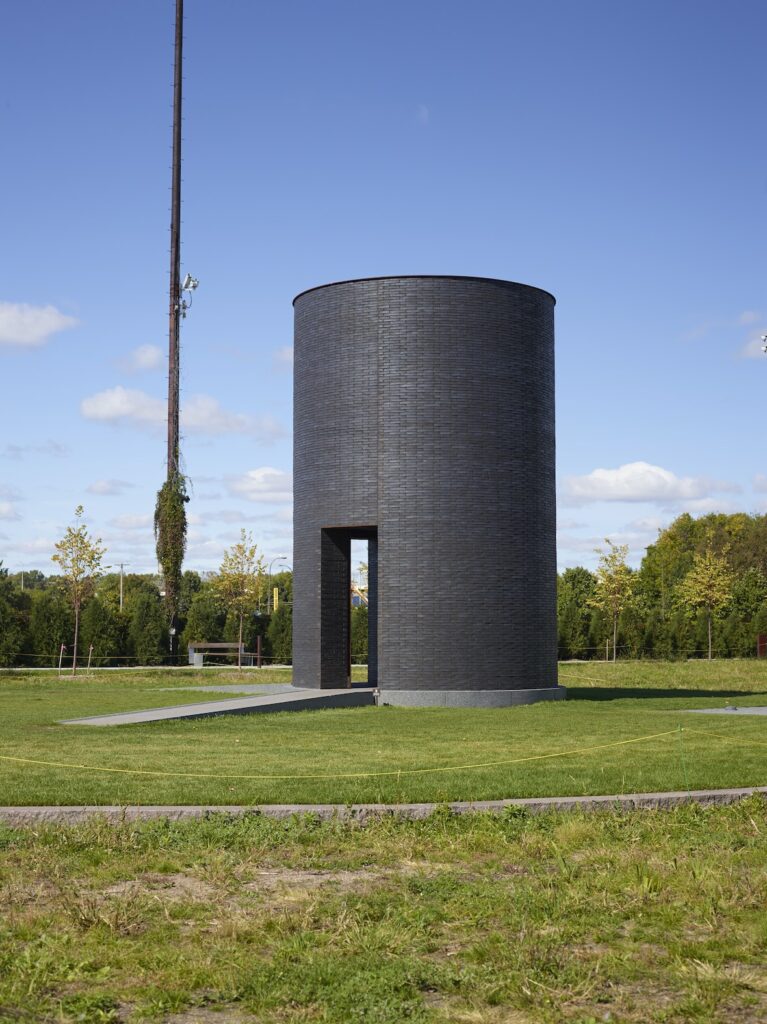
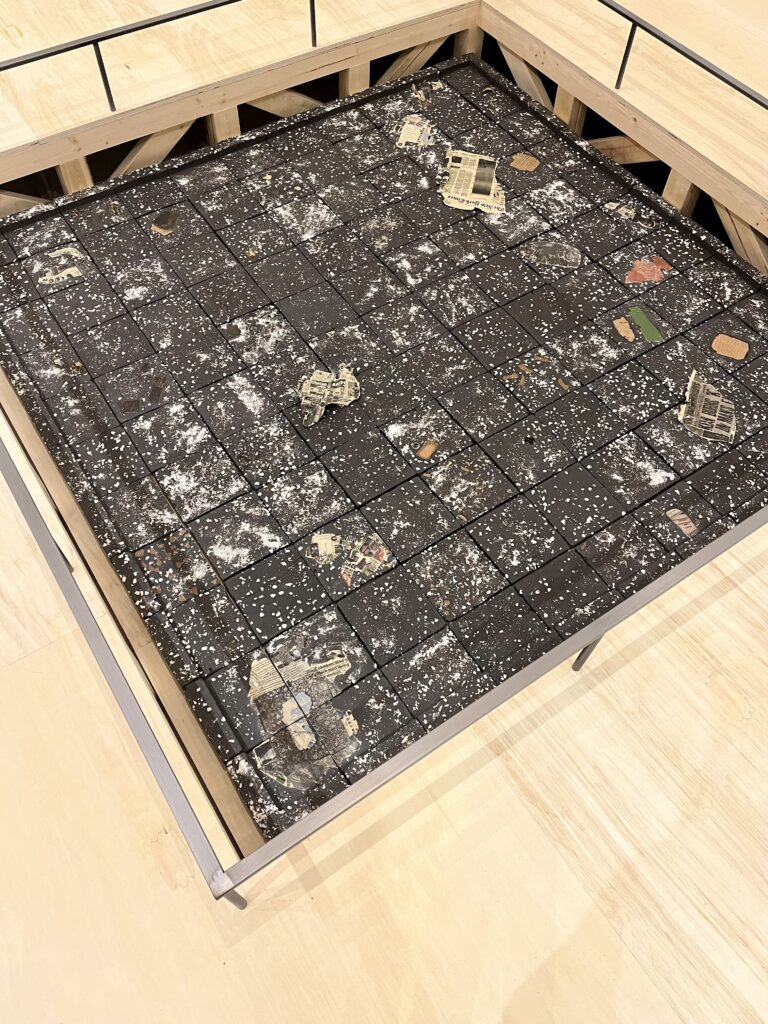
When visiting Archaeology of the Present, the smell of fresh-cut lumber emanates from the plywood scaffold, clinging to the air. The strong, woody odor conjures the unseen labor that Irving and the museum’s production team gave to construct the massive platform. Accompanying the smell is the sense that, like an excavation team proudly unveiling a new dig that might contribute to a greater understanding of human civilization, this scaffolding was hurriedly built to show visitors a set of urgently unraveling truths. Irving’s newspaper clippings and online printouts incorporate a dizzying array of sources: a strip sharing COVID-19 death tolls, a front page of the Chicago Tribune from the 1920s chronicling Ku Klux Klan violence, and a Wayfair advertisement selling television stands, to name a few. At first, I found myself wanting to tie these pieces together into some neat narrative about the space Irving is constructing. But such an approach seems to contradict the platform’s purpose: the installation does not seek a single vision of a city, but desires instead to create a common ground where place can be contemplated in all its conflicts and contradictions.
While driving home from the Walker, I try to avoid the gaping potholes that another Minnesota spring has ripped open. When I weave around a collection of splitting asphalt, I think of Irving’s hand-pressed tiles, which he hand-fired in another Midwestern city that looks much—and not at all—like this one. I think of the fact that, the next time I drive this road, the potholes will likely be covered up, the “slow-moving work” of road repair taking place while I’m asleep or otherwise not paying attention. The labor of these workers hold together a city that is constantly bursting open, remaking itself before it is paved over again.
A Lapse into the Ephemeral is on view at the Rochester Art Center until July 16, 2023. More information at rochesterartcenter.org. Archaeology of the Present is on view until January 21, 2024. More information at walkerart.org.